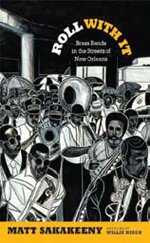When the energy of a social aid and pleasure club parade becomes particularly high and the forward motion of the second line feels unstoppable, the chant “Roll with it…” encourages the crowd to keep up the pace and propels it even further. In a book sporting such a spirited title, one would expect to get a taste of being among the throngs of people—the brass bands, club members, parade regulars and first-time participants—that are a part of this uniquely New Orleans tradition. And you do.
The author, a relative newcomer to the street culture, brings the reader along when he follows a “line,” led by the Rebirth Brass Band, and heads under the North Claiborne Avenue overpass. It is, as he learns from the experience and an interview with leader/tuba player Phil Frazier, a moment of great anticipation. Providing a ceiling of sorts that changes the acoustic qualities of the music, the overpass allows the brass instruments to echo with a force that kicks up the volume and ferocity.
Sakakeeny, an ethnomusicologist, musician and professor of music at Tulane University, also looks at the phrase “roll with it” from another, more academic, political, cultural and economic perspective. Through his interviews with brass-band members, primarily the Rebirth, Hot 8 and Soul Rebels, plus an array of music anthropologists and other academics, he found that, for the most part, the musicians, who are core to keeping the second-line tradition vital, have had to “roll with it” in dealing with the death and violence in their communities, insufficient wages, and just being taken for granted.
Roll With It, which includes striking black-and-white illustrations by New Orleans artist Willie Birch, is at once celebratory and saddening: a book of personal stories and a highly researched academic work.





